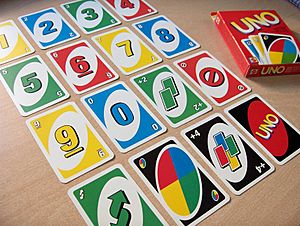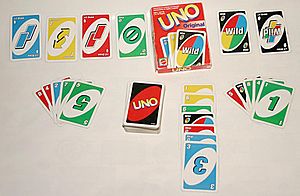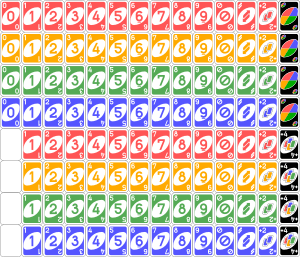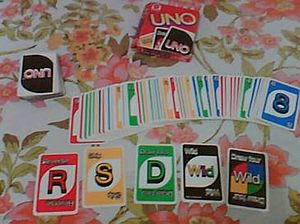Uno (card game) facts for kids
 |
|
| Designer | Merle Robbins |
|---|---|
| Publisher |
|
| Type | Shedding-type |
| Players | 2–10 players |
| Skills required | Hand management |
| Age range | 7+ |
| Cards | 112 |
| Playing time | Varies |
| Random chance | High |
Uno (which means 'one' in Italian and Spanish, and is often written as UNO) is a super popular card game from America. It's played with a special deck of cards. The main idea of Uno is like other "shedding" games, where you try to be the first to get rid of all your cards. It's quite similar to an old European game called Mau-Mau.
Mattel, a big toy company, has owned the Uno brand since 1992.
Contents
How Uno Started
Uno was created in 1971 by a man named Merle Robbins in Reading, Ohio. He loved playing card games with his family and friends. When they really enjoyed his new game, he decided to make 5,000 copies of it.
Merle first sold the game from his barbershop. Soon, other local shops started selling it too! Later, he sold the rights to Uno to a group of friends led by Robert Tezak. Tezak then started a company called International Games, Inc., just to sell Uno. In 1992, International Games became part of the Mattel company.
How to Play Uno
The main goal of Uno is to be the first player to reach 500 points. You get points by being the first to play all your cards in a round. Then, you score points for the cards still left in other players' hands.
The Uno Deck
A standard Uno deck has 108 cards.
- There are four "Wild" cards and four "Wild Draw Four" cards.
- There are 25 cards in each of four colors: red, yellow, green, and blue.
- For each color, you'll find:
- One "0" card.
- Two of each number from "1" to "9".
- Two "Skip" cards.
- Two "Draw Two" cards.
- Two "Reverse" cards.
The "Skip," "Draw Two," and "Reverse" cards are called "action cards."
Starting a Game
To begin a round, each player gets seven cards. The top card from the rest of the deck is flipped over to start the discard pile. The player to the dealer's left usually goes first. However, if the first card is an action or Wild card, special rules apply (see the table below).
Your Turn
When it's your turn, you must do one of these things:
- Play a card that matches the top card on the discard pile. It must match in color, number, or symbol.
- Play a "Wild" card.
- Play a "Wild Draw Four" card (but there's a special rule for this one).
- If you can't play a card, you must draw one card from the deck. If that card can be played, you can play it right away. If not, your turn ends.
Cards are played face-up on the discard pile. Play usually moves clockwise around the table.
Action and Wild Cards
These special cards change the game:
| Card | What it does when you play it | What it does if it's the first card |
|---|---|---|
| Skip | The next player in line misses their turn. | The player to the dealer's left misses their turn. |
| Reverse | The direction of play changes (clockwise becomes counterclockwise, or vice versa). | The dealer plays first, and play goes counterclockwise. |
| Draw Two (+2) | The next player draws two cards and misses their turn. | The player to the dealer's left draws two cards and misses their turn. |
| Wild | You choose the next color that must be played (red, yellow, green, or blue). You can play this card anytime. | The player to the dealer's left chooses the first color and plays a card of that color. |
| Wild Draw Four (+4 and wild) | You choose the next color. The next player draws four cards and misses their turn. You can only play this card if you don't have any cards of the current color. | This card is put back in the deck. The deck is shuffled, and a new card is flipped to start the discard pile. |
- If you draw a card from the deck, you can only play that specific card if it matches. You cannot play any other card from your hand.
- You can play a Wild card at any time, even if you have other cards you could play.
- You can only play a Wild Draw Four card if you do not have any cards that match the current color. You might have cards of a different color with the same number or symbol, or even a Wild card, and still play a Wild Draw Four. The next player can challenge you if they think you played it unfairly (see "Penalties").
- If the deck runs out of cards, the discard pile (except for the very top card) is shuffled to make a new deck.
- You are not allowed to trade cards with other players.
Calling "Uno!"
When you play your second-to-last card, you must shout "Uno!" This warns everyone that you only have one card left.
Winning a Round
The first player to get rid of their last card wins the round. They score points based on the cards left in other players' hands:
- Number cards (0-9) are worth their face value.
- Action cards (Skip, Reverse, Draw Two) are worth 20 points each.
- Wild and Wild Draw Four cards are worth 50 points each.
If you go out by playing a Draw Two or Wild Draw Four card, the next player still has to draw those cards before scores are counted. The first player to reach 500 points wins the entire game!
Uno Penalties
- If you forget to call "Uno!" when you have one card left, and another player catches you before the next player takes their turn, you must draw two penalty cards. If no one catches you in time, or you remember to say "Uno!" before being caught, there's no penalty.
- If you play a Wild Draw Four card, the next player can challenge you. You must then secretly show your hand to the challenging player to prove you didn't have any cards of the current color.
- If you were wrong (you did have a matching color card), you must draw four cards instead.
- If the challenger was wrong (you played it correctly), they must draw six cards (the four they would have drawn, plus two more).
Two-Player Game
In a game with only two players, a Reverse card works just like a Skip card. When you play it, the other player misses their turn.
Popular House Rules
Many people play Uno with their own special rules. Here are some common ones:
- Progressive or Stacking Uno: If someone plays a Draw Two or Wild Draw Four, and the next player has the same type of card, they can play it to "stack" the penalty. This means the next player has to draw even more cards! (But a +4 cannot be stacked on a +2, or vice versa).
- Seven-O: When a "7" is played, the player who played it must swap all their cards with any other player they choose. When a "0" is played, all players pass their hands to the next player in the current direction of play.
- Jump-In: If you have a card that is exactly the same (same number AND color) as the top card on the discard pile, you can play it immediately, even if it's not your turn! Play then continues from you.
- Keep-Drawing: If it's your turn and you don't have a playable card, you keep drawing cards from the deck until you find one you can play.
New Wild Cards (2018)
In 2018, Uno introduced two new types of Wild cards:
- Wild Shuffle Hands: When you play this card, you collect all the cards from every player. Then, you shuffle them all together and deal them out again, starting with the player to your left.
- Wild Customizable: There are three blank cards in the deck. You can write your own house rules on these cards!
These new Wild cards can be played at any time and are worth 40 points if you go out with them.
Recent Rule Changes (2022)
Uno officially changed its rules in 2022. The main goal is now simply to be the first player to get rid of all your cards. If you are playing for points, Wild cards are now worth 50 points again. Also, if the very first card flipped at the start of a game is an Action or Wild card, it's ignored, and another card is flipped until a number card appears.
Uno Strategies
When playing Uno, you can use different plans. An offensive plan means you try to get rid of your cards quickly to win the round. A defensive plan means you try to have cards with low point values, just in case another player wins first. A good Uno player knows when to switch between these plans.
For example, an offensive player might save Wild and Wild Draw Four cards for the end of the round. This is because these cards can help them go out when it's hard to find a matching card. But a defensive player might get rid of these cards early because they are worth a lot of points.
Another example: A defensive player might play a high-number card to reduce their hand's point value. An offensive player might play a "0" card when they want to keep the current color going. This is because there's only one "0" of each color, making it less likely another player has a "0" of a different color to match.
If you have only one card left, you must call "Uno!" But sometimes, players might try not to say "Uno!" hoping no one notices, so they can win on their next turn. It's smart to try and hide how many cards you have and to keep track of how many cards other players have.
Card and Deck Styles
Modern Uno action cards have symbols that show what they do. For example, a circle with a line through it for "Skip." Older English versions of the game used to have letters instead of symbols on these cards. You can also spot older decks because they don't have the white border around the edge of the cards.
Some Uno decks use symbols and pictures instead of words, even on the Wild cards. There are also versions made for people with color blindness, like "Uno ColorAdd" (released in 2017). In 2019, Mattel even released a Braille version of Uno, which helps blind people play the game with friends and family.
Special Uno Games
- Uno 50th Anniversary (2021)
- Uno Wild Twists (2022)
- Uno All Wild (2022)
- Uno Attack (1999)
- Uno Attack Jurassic World (2018)
- Uno Attack Refill Deck (2005)
- Uno Bingo (1997)
- Uno Blast (2012)
- Uno Blitzo (2000)
- Uno Choo-Choo (2011)
- Uno Color Screen
- Uno Deluxe (2022)
- Uno Dare (2014)
- Uno Dice (1987, 1996, 2011)
- Uno Dominoes (1986)
- Uno Emoji (2016)
- Electronic Uno (2020)
- Uno Flash (2007)
- Uno Flex! (2023)
- Uno Flip (2009)
- Uno Flip! (2019)
- Get Wild for Uno (2016)
- Giant Uno (2016)
- Giant BTS Uno (2020)
- Uno Go! (2022)
- Uno H2O (2004)
- Uno H2O To Go
- Uno Harry Potter (2019)
- Uno Hearts (1994)
- Uno Junior (1992)
- King Size Uno (1994)
- Uno Lightyear (2021)
- Uno Madness (1995)
- Uno Minecraft (2018)
- Uno Moo (2008, 2014)
- Uno Show 'Em No Mercy (2023)
- Uno Party! (2022)
- Uno Power Grab (2012)
- Uno Remix (2022)
- Uno Reflex (2010)
- Uno Roboto (2010)
- Uno Royal Revenge (2014)
- Uno Rummy Up (1993)
- Uno Showdown Supercharged (2020)
- Uno Spin (2005)
- Uno Spin Hannah Montana (2005)
- Uno Spin One Piece (Japan)
- Uno Spin To Go (2010)
- Uno Stacko (1994)
- Travel Uno Stacko
- Uno Tippo (2009)
- Uno Tiki Twist (2014)
- Uno Triple Play (2021)
- Uno Wild Jackpot (2016)
- Uno Wild Tiles (1982)
Uno H2O
Uno H2O is a special version of Uno where the cards are clear and waterproof! This means you can play it near water without worrying about ruining the cards. The game rules are mostly the same as the regular Uno game before 2018. It also includes two special "Wild Downpour" cards. When one of these is played, all other players must draw either one or two cards, as shown on the card. The player who used the card then chooses the next color.
Uno Video Games
- Uno (handheld video game) – 2000
- Uno (handheld video game for the Game Boy Color)
- Uno DX (Japanese exclusive Sega Saturn game) – 1998
- Uno (PlayStation Network)
- Uno (Xbox Live Arcade)
- Uno Rush (Xbox Live Arcade)
- Uno Challenge (mobile version)
- Uno Free Fall (puzzle game for mobile phones)
- Uno 52 (Game Boy Advance)
- Super Uno (Super Famicom)
- Uno (Facebook) (Adobe Flash–based version)
- Uno (iPhone)
- Uno (iPad)
- Uno (Android)
- Uno (DSi)
- Uno (WiiWare)
- Uno & Friends (various platforms)
- Pocket Uno
- Uno and Uno & Friends for Windows Phone
- Uno Undercover (Windows)
- Uno (2016 video game for PC, PlayStation 4 and Xbox One)
- Uno (2017) – the 2016 game release on the Nintendo Switch)
Other Uno Games
There are many different ways to play Uno, like Elimination Uno or Speed Uno.
In 2018, Mattel released a new game called Dos, which is similar to Uno but has some new rules. For example, it has a "center row" where you can discard cards that add up to a certain number.
You can even play a version of Uno using two regular decks of playing cards!
Uno in Movies
In 2021, it was announced that a movie based on the Uno game was being planned. It's supposed to be an action-comedy film!
See also
 In Spanish: Uno (juego) para niños
In Spanish: Uno (juego) para niños





